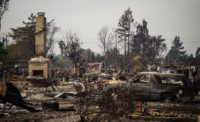Sports and Entertainment Come Together at France's Espace Mayenne

Architects & Firms
“This building is like a Swiss Army knife,” says Yves Arnod—one half, with Isabel Hérault, of Paris-based Hérault Arnod Architectures—about the Espace Mayenne, a multifunctional facility for spectator sports, live entertainment, and business fairs. Commissioned by the département of La Mayenne, in northwestern France, it is located on the outskirts of Laval—La Mayenne’s administrative center, a town of 50,000 inhabitants with a picturesque medieval center—on a former military site that is being transformed into a sustainable neighborhood. Situated halfway between Le Mans and Rennes, La Mayenne is essentially rural, but is nonetheless home to several large businesses, among them the international dairy concern Lactalis. The local government’s ambition in building the $42 million Espace Mayenne was to provide facilities that were lacking and boost the area’s attractiveness.

A cycle track flanks Espace Mayenne, which is wrapped in a skirt of perforated and striated white sheet-aluminum (above and top). Photo © Cyrille Weiner, click to enlarge.
According to Sophie Bonnière, the département’s deputy general director for infrastructure, Hérault Arnod won the 2015 design competition not only because of their previous experience with sports and entertainment venues, but because their scheme best concentrated the program into the most compact form. Located next to Laval’s ring road, with fields on one side and the new neighborhood on the other, the design for the 25-acre site conserved typical pastureland features, including a stand of beautiful old oaks, a hedgerow-lined lane, and a wet zone. To minimize impact, the team placed the public parking at one end of the site (which had already been paved by the army) and nestled the building into a hollow whose 13-foot drop allowed the architects to put the public entrance on one side, at mid-height in relation to the main auditorium, and the staff/artists’ entrance on the other, on the lower level, with its own parking next to the ring road. Landscaping, by the Paris office Sempervirens, is an important part of the project, and includes planted swales to drain the public parking; meadows for recreation; and a tree- and wildflower-lined mall linking the parking area to the Espace Mayenne’s public entrance. Among the sports facilities are an outdoor international-standard cycle track, around which Sempervirens planted pines to avoid the hazard of wet leaves in the fall.
The Espace Mayenne proper contains three spectator halls. The smallest is a 500-seat auditorium/screening room tucked into the side of the hollow. The second, accommodating between 700 and 2,217 people, depending on configuration, hosts handball, basketball, and volleyball matches, and also contains a 54-foot-high international-standard climbing wall. The largest, the Salle Mayenne, is a gigantic multifunction arena that can hold 4,300 people for shows (programming ranges from Swan Lake with a full orchestra to standup comedians), 3,680 for indoor soccer matches, and 4,475 for boxing. The three halls share a forecourt and entrance, with distances from the entrance to each reduced to a minimum, and dressing/changing rooms slipped into interstices. The lower (ground) floor also includes three reception rooms, which can be joined together as one, for corporate sponsors, who enjoy privileged access to the Salle Mayenne.

An international-standard climbing wall is one of the center’s highlights. Photo © Cyrille Weiner
To have uninterrupted sightlines, there are no columns: all three halls were realized using massive concrete perimeter walls (as well as concrete bleachers for the Salle Mayenne) that are spanned by steel beams, which stretch 200 feet in the case of the main arena.
A spaceship-like form (1) conceals a variety of performance areas, including a multifunction arena (2). Photos © Cyrille Weiner, click to enlarge.

1

2
Outside, to tie together the halls’ rather disparate forms, three bands of white-lacquered sheet aluminum wrap around the building in a skirt, the upper and lower bands being diagonally striated while the middle one is perforated (at the rear, the perforations allow airflow to the HVAC equipment on the roof). “We wanted our building to be stealthy,” says Arnod of the distinctly spacecraft-like result, whose whiteness was intended to blend in with the nubilous Mayennais skies. Hidden behind the oak trees as you arrive from the parking lot, this strange object—a little ungainly from certain angles—is the pure product of interior concerns, the enormous skirt lifting here and there to reveal rows of windows and forming a deep entrance soffit on the public forecourt, while the lower ground floor is faced unassumingly in pale board-marked concrete.

Douglas fir slats trace out the complex geometry of the foyer ceiling. Photo © Cyrille Weiner
A certain discretion continues inside the building, in keeping with a region averse to ostentation, with its neat stuccoed houses that often verge on the dreary. The Espace Mayenne’s interior material palette is reduced essentially to wood, concrete, and felt, all in shades of gray and beige, such as the Douglas fir slats that elegantly trace out the complex geometry of the foyer ceiling. “Acoustic performance was a big issue—the essential battle,” says Arnod. “A hall with poor acoustics gets a bad reputation, and performers won’t come.” The thick concrete walls insulate the three halls from each other, while a whole panoply of tricks was deployed in the Salle Mayenne: deflecting concrete alternating with absorbent felt, felt squares hung from the 13-foot-high technical ceiling, felt-lined grills in the risers under the bleacher seating (so the hall absorbs as much sound when empty as when full), and cavities placed at strategic points to moderate the bass (just as the Romans used amphorae beneath the seating of their amphitheaters). Impeccably realized by local contractors who clearly took pride in their contributions, this is a lean, sober spectacle machine that leaves it to the players, performers, and audience to supply the warmth and ambience.
Click drawing to enlarge

Click drawing to enlarge

Credits
Architect:
Hérault Arnod Architectures — Mickael Dusson, project director; Jérôme Moenne-Loccoz, project manager; Paola Figueroa, Thomas Féraud, Rana Abi Ghanem, architects; Florent Bellet, construction manager; Arnaud Gillet, construction-site supervision
Consultants:
Batiserf (structural); Inex (mechanical); Lasa (acoustic); Sempervirens (landscape)
Client:
Mayenne Department Council
Size:
163,000 square feet
Construction Cost:
$37 million
Completion Date:
June 2021
Sources
Structural System:
Cardinal Edifice, ERTCM Industries, Albizzati Père & Fils
Exterior Cladding:
Cardinal Edifice, Raimond, Druet, Cruard
Windows:
Dupré, Gouelle, Atelier David
Climbing Wall:
Escatech
Lighting:
Cegelec
Elevators:
Orona







